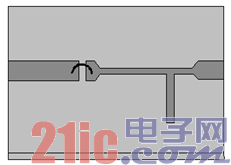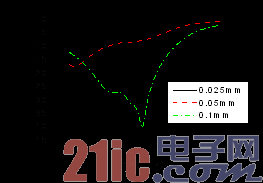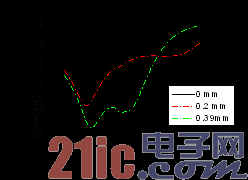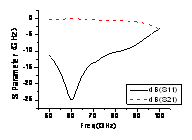introduction
This article refers to the address: http://
Key alloy wire interconnect technology has a wide range of applications in microwave integrated circuits (MICs) and monolithic integrated microwave circuits (MMICs), which can be used for connection of solid state devices to passive circuits, as well as for connection between chips. However, the use of this interconnection method at the high end of the millimeter wave is limited because the distribution current of the microstrip line is affected at the junction of the gold wire and the microstrip line, and the inductance is exhibited. In order to solve this problem, flip chip and other electromagnetic coupling technologies have been proposed. However, the key alloy wire interconnect structure still has a wide range of applications, mainly because it has the advantages of simple process, low cost, small thermal expansion coefficient, etc., which is of great significance in highly demanding applications, especially space systems. Practice has proved that as long as the design of a suitable matching network, the key alloy wire interconnect structure can achieve good matching performance.
The method of electromagnetic field numerical calculation can obtain accurate bonding parameter model. The commonly used time domain finite difference method based on full wave analysis and quasi-static analysis method are also used. The fifth-order low-pass filter is formed by the bonding wires for the connection of the two glass chips, and although a wide-band matching connection can be realized, the chip is more demanding. In this paper, for the broadband matching interconnection of millimeter wave, the method of additional microstrip tuning branch is adopted, and the broadband matching interconnection of microstrip bond alloy wire suitable for V and E bands is analyzed and designed, and the thickness, number and spacing of the bond alloy wire are The effect of the microstrip tuning branch line on the reflection and transmission characteristics of millimeter waves was compared.
2-bond alloy wire interconnection model and its equivalent circuit
The bond wire interconnection model with microstrip blending branches studied in this paper is shown in Fig. 1. On the dielectric substrate of Rogers 5880 with a thickness of 0.127 mm, the two microstrips with fixed width and gap are connected by gold wire. In order to adjust the reactance effect of the bond wire, the microstrip branching structure is added. The equivalent circuit of the entire interconnect structure is shown in Figure 2:

(a) single gold wire

(b) double gold wire
Fig.1 Key alloy wire interconnection model with microstrip deployment branch

Fig.2 Simulation and analysis of the equivalent circuit key alloy wire interconnection model of the key alloy wire interconnection model
3.1 The number of gold wires, the thickness, the spacing and the effect of the microstrip blending branch line on the reflection characteristics
Taking HFSS, the reflection characteristic curves of different gold wire thickness, number and spacing were calculated. The results are shown in Figure 3-5. Figure 3 shows the reflection coefficient frequency response curves of the three gold wire diameters in a single gold wire structure. It can be seen that the thicker the gold wire is, the smaller the reflection coefficient is. Therefore, we should choose a thicker gold wire in the optional range. Figure 4 shows the effect of the double gold wire spacing on the reflection coefficient. It can be seen that the larger the distance, the smaller the reflection parameter. This is because the horizontal distance between the two lines is close to the line width of the microstrip, which can reduce the equivalent. Series inductance. Figure 5 shows the variation of S11 with the number of bond alloy wires. It can be seen from the figure that the double gold wire is obviously superior to the single gold wire transmission characteristics, but it is not the number of gold wires. The better, the three gold wire, four The transmission characteristics of gold wire and metal wire are getting worse as the number of gold wires increases.
We introduce a microstrip tuning branch line to tune the inductance characteristics of the gold ribbon. Figures 6 and 7 show the effect of the length and width of the microstrip on the reflection characteristics. Adjusting the length and width of the microstrip can produce the desired frequency band. Good reflection characteristics.

Figure 3 Effect of gold wire diameter on S11 (single gold wire)

Figure 4 Effect of gold wire spacing on S11 (double gold wire)

Figure 5 The effect of the number of gold wires on S11

Figure 6 Effect of Tuning Microstrip Branch Line Length on S11

Fig. 7 Effect of tuning microstrip branch line width on S11 3.2 Optimization results and main structural parameters
For the double gold wire structure shown in Fig. 2(b), after examining the influence of each main parameter on the transmission characteristics, we obtained a better output S parameter characteristic curve after optimization. As shown in Fig. 8, it can be seen that the microstrip The insertion loss simulation results of the bond wire interconnect structure in the frequency range of 50 GHz to 80 GHz are all less than 0.65 dB. The main structural parameters are shown in Table 1:
Table 1 Main structural parameters of double gold wire
W1 | 0.45 mm | M2 | 0.19 mm |
d | 0.1 mm | Tl | 0.39 mm |
s | 0.1 mm | Tw | 0.05 mm |
M1 | 0.9 mm | W2 | 0.14 mm |

Figure 8 Optimized S-parameter characteristic curve
4 Conclusion
In this paper, a millimeter-wave bond wire interconnect structure with microstrip blending branch lines is analyzed and designed. At the same time, we also investigate the thickness, number, spacing of the gold wire and the influence of the tuning microstrip branch line on the reflection parameters. By optimizing the structural parameters, the insertion loss simulation results of the bond wire interconnect structure in the frequency range of 50 GHz to 80 GHz are less than 0.65 dB, which is suitable for the broadband matching interconnection of V and E bands.
Aluminium Truck Body,Aluminum Panel Sheet,Polished Aluminum Sheet,Aluminium Alloy Sheet
KAM KIU ALUMINIUM GROUP , https://www.kamkiualuminium.com